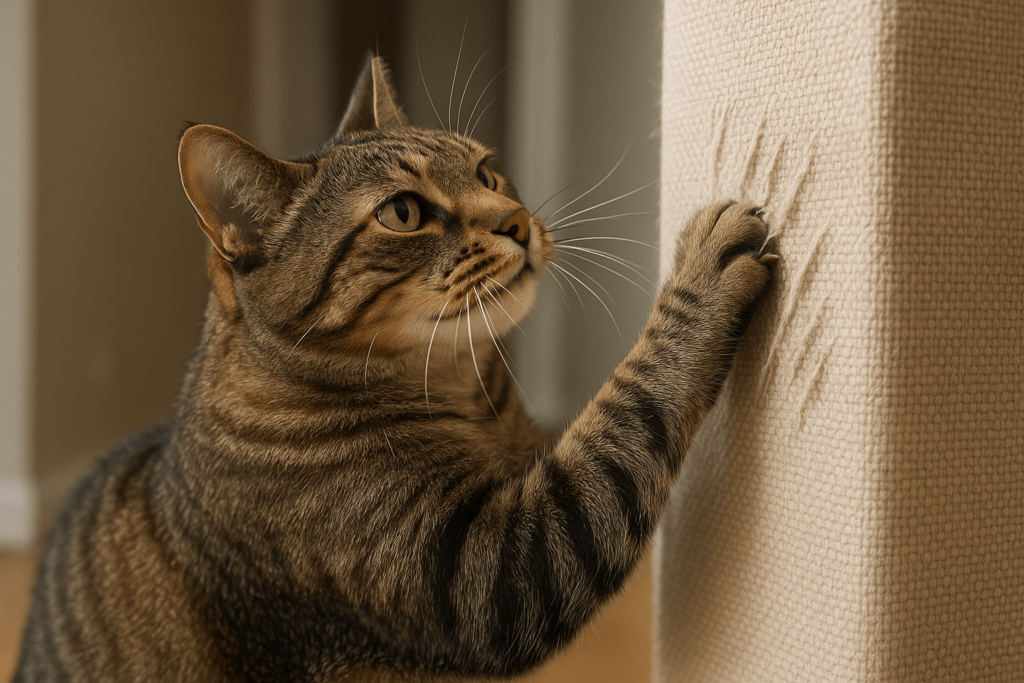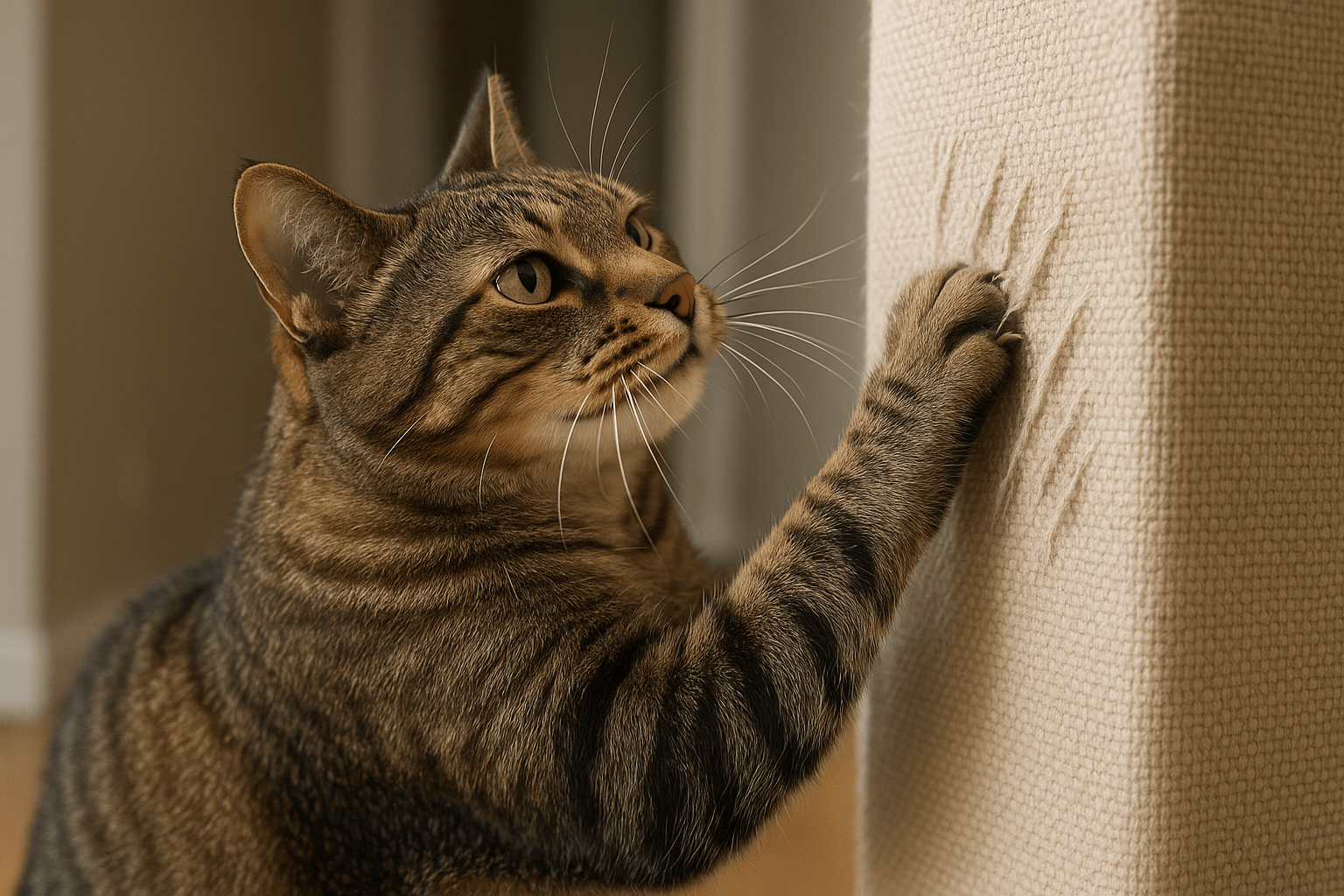Why Does a Cat Scratch? Understanding This Natural Behavior
Cats are fascinating creatures, and one of their most common behaviors is scratching. Whether it’s your furniture, a scratching post, or even the carpet, this action is more than just a random habit—it serves several important purposes in a cat’s life. Scratching is an instinctual behavior deeply rooted in their biology, and understanding why cats scratch can help you redirect this behavior in a way that benefits both you and your feline friend. In this blog post, we’ll explore the reasons behind scratching, its benefits, and how to manage it effectively without compromising your home or your cat’s well-being.
The Instinctual Reasons Behind Scratching
Scratching is a natural behavior for cats, driven by instincts that have evolved over thousands of years. These reasons explain why your cat feels compelled to scratch surfaces around your home.
Territorial Marking:
Cats have scent glands in their paws, and scratching leaves behind both visual marks and scent cues to claim their territory.Nail Maintenance:
Scratching helps remove the outer layer of their claws, keeping them sharp and healthy.Stretching Muscles:
The act of scratching allows cats to stretch their muscles, particularly in their back and shoulders, promoting flexibility and comfort.Stress Relief:
Scratching can serve as a way for cats to release pent-up energy or anxiety, much like humans might pace or fidget.Play and Exploration:
Kittens and young cats often scratch during play as part of their natural curiosity and exploration of their environment.
Understanding these instinctual drives can help you appreciate why scratching is so important to your cat’s physical and emotional health.

Health Benefits of Scratching for Cats
Scratching isn’t just about marking territory or maintaining nails—it also provides significant health benefits for your cat. Here’s how this behavior contributes to their overall well-being.
Improved Claw Health:
Regular scratching prevents overgrown nails and reduces the risk of ingrown claws or infections.Muscle Tone and Flexibility:
The stretching motion involved in scratching strengthens muscles and improves joint mobility.Mental Stimulation:
Scratching engages a cat’s mind, providing mental stimulation and reducing boredom.Emotional Balance:
Scratching releases endorphins, which help reduce stress and promote feelings of calmness.Behavioral Expression:
Allowing cats to scratch freely supports their natural instincts, leading to happier and more balanced pets.
By encouraging appropriate scratching, you’re not only protecting your home but also supporting your cat’s physical and mental health.
Check this guide 👉Why Is My Cat Scratching the Window? Best 7 Expert Tips!
Check this guide 👉Cat Scratched Dog Eye White Spot: Best 7 Expert Tips!
Check this guide 👉Why Do Cat Scratches Itch? Best 7 Expert Tips!
| Reasons Cats Scratch | How It Benefits Them |
|---|---|
| Territorial Marking | Establishes ownership of space. |
| Nail Maintenance | Keeps claws sharp and healthy. |
| Stretching Muscles | Promotes muscle tone and flexibility. |
| Stress Relief | Reduces anxiety and tension. |
| Play and Exploration | Encourages curiosity and learning. |
Common Surfaces Cats Love to Scratch
Cats tend to gravitate toward certain surfaces when scratching, depending on texture, location, and personal preference. Knowing these preferences can help you choose the right scratching solutions for your home.
Upholstered Furniture:
Sofas and chairs are popular due to their soft, sturdy surfaces that mimic tree bark.Carpets:
The plush texture of carpets provides resistance, making them ideal for claw filing.Wooden Furniture:
Hardwood surfaces allow cats to leave visible scratch marks, satisfying their territorial instincts.Cardboard Boxes:
Many cats enjoy scratching cardboard because it’s easy to shred and offers auditory feedback.Drapes and Curtains:
The vertical nature of drapes appeals to cats’ climbing and stretching instincts.
Understanding these preferences can help you redirect scratching toward appropriate alternatives.
How to Redirect Scratching Behavior
Redirecting your cat’s scratching behavior requires patience and consistency. Here are some practical steps to guide them toward appropriate surfaces.
Provide Scratching Posts:
Place sturdy scratching posts near areas where your cat frequently scratches.Use Positive Reinforcement:
Reward your cat with treats or praise when they use designated scratching surfaces.Discourage Unwanted Scratching:
Apply double-sided tape or citrus scents to discourage scratching on furniture.Experiment with Materials:
Offer a variety of textures, such as sisal, carpet, or cardboard, to find what your cat prefers.Trim Their Nails Regularly:
Keeping your cat’s nails trimmed reduces damage to household items.
With time and effort, you can successfully redirect your cat’s scratching habits.
Choosing the Right Scratching Post
Selecting the right scratching post is crucial for satisfying your cat’s needs and protecting your home. Consider these factors when making your choice.
Height and Stability:
Tall posts allow cats to stretch fully, while stable bases prevent tipping.Material Variety:
Different materials cater to individual preferences—sisal for roughness, carpet for softness.Placement Matters:
Position posts near high-traffic areas or previously scratched surfaces.Vertical vs. Horizontal Options:
Some cats prefer vertical posts, while others favor horizontal pads.Interactive Features:
Incorporating toys or dangling strings can make posts more appealing.
A well-chosen scratching post can transform your cat’s behavior and save your furniture.
Signs Your Cat Needs More Scratching Outlets
If your cat is excessively scratching inappropriate surfaces, it may indicate a need for additional outlets. Look out for these signs.
Increased Aggression:
Frustration from lack of scratching options can lead to aggressive behavior.Frequent Furniture Damage:
Persistent scratching of furniture suggests insufficient alternatives.Overgrown Nails:
Long nails may indicate your cat isn’t getting enough opportunities to file them down.Restlessness or Anxiety:
Boredom or stress can manifest as destructive scratching.Attempts to Escape:
Cats may try to escape if they feel confined and unable to express natural behaviors.
Addressing these signs ensures your cat has adequate outlets for their scratching needs.
Preventing Scratching Damage in Your Home
While scratching is natural, it doesn’t have to ruin your belongings. Here are effective strategies to minimize damage.
Protect Furniture:
Use slipcovers or protective sprays to shield upholstery from scratches.Create a Cat-Friendly Zone:
Designate a specific area with scratching posts and toys to satisfy your cat’s instincts.Regular Playtime:
Engage your cat in interactive play to burn off excess energy and reduce destructive behavior.Provide Alternatives:
Offer a variety of scratching surfaces to meet your cat’s diverse preferences.Consult a Veterinarian:
If scratching becomes obsessive, seek advice to rule out underlying medical or behavioral issues.
Taking proactive measures ensures harmony between your cat and your home.
Frequently Asked Questions About Cat Scratching
Why does my cat scratch furniture instead of the scratching post?
Your cat may prefer the texture or location of the furniture. Experiment with different materials and placements.
How can I stop my cat from scratching curtains?
Provide vertical scratching posts and apply deterrents like citrus sprays to the curtains.
Is declawing a safe option to stop scratching?
Declawing is controversial and considered inhumane by many experts. Focus on training and alternatives instead.
How often should I trim my cat’s nails?
Trim your cat’s nails every 2–4 weeks to prevent overgrowth and reduce scratching damage.
What if my cat ignores all scratching posts?
Try different textures, heights, and locations until you find what appeals to your cat.
Embracing Your Cat’s Natural Instincts
Scratching is an essential part of a cat’s life, fulfilling physical, emotional, and instinctual needs. By understanding why cats scratch and providing appropriate outlets, you can create a harmonious living environment that respects their natural behaviors. With the right tools, training, and mindset, you can protect your home while nurturing your cat’s well-being. Remember, a happy cat means a happy home—and embracing their instincts is the first step toward achieving that
Canned Pumpkin for Cat Diarrhea: Best 7 Expert Tips! Natural remedy to firm stools, soothe upset bellies, and support gut health safely.
Can a Cat Give You Scabies? Best 7 Expert Tips! Discover the truth about feline mites, human skin risks, and how to protect yourself—without panic.
Cat Flea vs Human Flea: Best 7 Expert Tips! Discover the truth about bites, species, and how to eliminate infestations for good.
Weird Cat Behaviors: Best 7 Expert Tips! Discover why cats do strange things—and how to understand, not punish, their instincts for a happier home.





